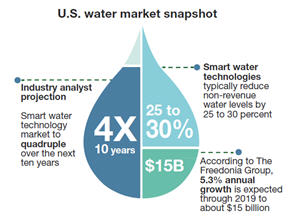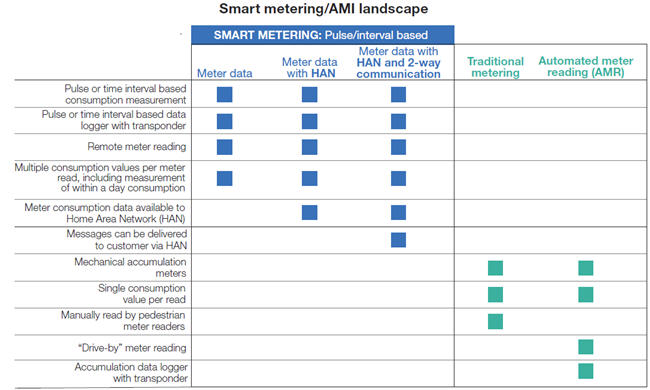Maximizing Water And Wastewater Opportunities
An urgent imperative to improve or replace infrastructure
As pressures on water resources and wastewater infrastructure systems continue to rise, municipalities must address a difficult question: How can they continue to deliver the same quality of water and related services while at the same time minimize rate increases, balance capital budgets, and still remain within their debt limits? Even in the midst of economic uncertainty and geopolitical instability, one resource continually increases in value: Water. Whatever the prevailing financial conditions, the price of water — and the demand for it — grows higher with each passing day.
Background
There are several megatrend forces that create exceptional demand and challenges for water resources. They include:
- Water scarcity/effluent content deficiencies
- Population growth
- Industrial expansion
- Urbanization
- Aging infrastructure
- Unfunded mandates
- Increasingly stringent regulations
These challenges have engendered a variety of new, helpful strategies and tactics, such as:
- Advancements in technology and IT
- Infrastructure development and renewal
- Increased private sector investment
- Legislative support
- Water resources for food and energy security1
As stakeholders in the management of water resources, we face the urgent imperative to improve or replace existing water infrastructure and systems. We also recognize the high costs of necessary equipment and operating expenses associated with such endeavors.
Market Trends
In domestic water markets, the following trends play significant roles:2
- Decreased consumption:
Treatment and reuse of wastewater point to sustained efforts to decrease water consumption.
- Increased treatment standards:
Industrial markets have increased treatment standards in manufacturing, resource extraction and power generation.
- Limited availability of fresh, potable water:
As drinking water supplies decrease, municipal suppliers seek water from alternative sources (such as reuse and desalination, among others).
- Advanced Metering Infrastructure (AMI):
Water AMI establishes two-way communication between a water meter and a utility company, giving the utility real-time data about water distribution and consumption. At the same time, AMI helps customers make informed decisions about their water usage, based on pricing and time of day.
AMI technology also has the capacity for system-wide monitoring of water supplies and distribution. For example, U.S. water utilities lose an estimated 30 percent of water to leaks in their distribution systems — a problem easily detected and located by an AMI system.3
Market Snapshot
 Utilities
Utilities
Within the U.S., two entities control the American water markets: Utilities and general water and wastewater services. Municipal utilities owned and operated by local governments represent the most significant share of the water market, managing and maintaining 84 percent of community water systems and 98 percent of community wastewater systems.4 They also tend to be highly fragmented — they control 53,000 community water systems and 16,000 wastewater facilities5 — and therefore present the greatest opportunity for growth and development. Secondary to municipal utilities, large-scale, investor-owned utilities (IOUs) dominate the private American market.
General Services
Both municipal and private utilities rely heavily upon the general services market. This market consists largely of engineers, consultants and distributors of products and services related to water and wastewater infrastructure.
Industry Solutions
The rapidly expanding water market has given rise to ambitious legislative initiatives and a range of sophisticated equipment and technology solutions, most of which are capital-intensive. While the solutions are vast and their impact far-reaching, so are the costs to install innovative systems. Comprehensive infrastructure improvements incur expenses that are often prohibitive, especially for municipalities with already constrained capital budgets.
Table 2: Smart metering/AMI Landscape

Smart water and AMI technologies
Smart water and AMI technologies are on a fast track to benefit both utilities and their customers, with data collection and management playing a critical role to decrease operating costs, identify performance issues and improve customer service (see Table 2). In fact, smart water technologies typically reduce non-revenue water levels by 25 to 30 percent in the first 18 months of usage6. In the U.S., water utilities will spend $2 billion on smart metering infrastructure through 2020, and as a result, the average water utility is expected to save up to $2 million a year.7
Legislative leadership
On the legislative front, California and Colorado lead the country in water initiatives:
- Major projects in California include upgrades to the Sacramento Regional Wastewater Treatment Plant.
- Colorado is now developing a long-term water plan that addresses additional resources and uses of shared water sources, without negative environmental impact.
- The Graton Community Services District in Sonoma County, California will need to upgrade its wastewater treatment plant by 2017 in order to eliminate agricultural contaminants, including nitrates from manure and fertilizer.
Nationally, the EPA continues to advocate increasingly stringent rules for improved water quality.
Financing: Immediate, Cost-Effective Capital
Utilities (municipal and private) and general service providers often look to equipment financing as a practical funding alternative with which to meet the urgent demands of our water crisis. Unlike a traditional loan or tedious and restrictive bond initiative, equipment financing features fixed monthly payments and attractive rates — including tax-exempt pricing for municipalities. Consequently, financing expedites the construction of critical systems and accelerates revenue recapture.
In addition to being an immediate source of capital, equipment financing also offers greater flexibility. For instance, leveraging an operating lease bypasses the roadblock of a strapped capital expenditures (CAPEX) budget, as it creates the ability to include provisions for Managed Services solutions (when desired). Plus, all project costs, ranging from procurement, installation and maintenance plans to customer service and asset management functions, can be bundled into one payment schedule. Regardless of the size or scope of the project, financing helps municipalities and their suppliers realize both short- and long-term profitability through a host of additional benefits and features, including:
- Enhanced cash flow
- Flexible terms and payment schedules
- Eliminated Costs of Issuance
- Expedited processing
- Progress payments
- 100 percent funding
Innovative solutions and long-range strategies are central to correcting the state of our water infrastructure. While the economic benefits of equipment financing are instrumental in achieving sustainable water infrastructure, a steadfast, knowledgeable funding provider is equally important. A financing partner with reliable capital and financing expertise can help facilitate a successful project. Your partner should also have experience within the fields of water, energy, IT and metering technologies, and municipal regulations.
Summary
Decades of deferred maintenance and unreasonably low water pricing have pushed our systems to their breaking points. Our water resources are decreasing at alarming rates and our infrastructure is in critical need of repair or replacement. Legislative action and technological advances offer hopeful solutions. However, they come at a high cost in the face of restricted capital budgets. In addition, customer rates and fees alone are not sufficient to fund current and future system improvements. In contrast, creative financing provides utilities and their suppliers with expedited access to cost-effective capital. The possession of financial resources empowers you and your enterprise to take the actions required to preserve, protect and successfully manage our nation’s water supplies.
To learn more, visit www.keyequipmentfinance.com; Contact: Tom Waters, Vice President, Water Infrastructure Finance, Key Equipment Finance, 720.304.1226, Thomas.P.Waters@key.com
1. UNESCO-IHE Institute for Water Education, “Water, Food & Energy Security” https://www.unesco-ihe.org/research-themes/water-food-energy-security
2. Water Efficiency Journal, http://www.gwfathom.com/wp-content/uploads/2015/04/2014M-AMI_Three_Rs.pdf
3. WaterWorld, “Advanced Metering Infrastructure: Drivers and Benefits in the Water Industry,”http://www.waterworld.com/articles/print/volume-27/issue-8/editorial-features/special-section-advanced-metering-infrastructure/advanced-metering-infrastructure-drivers-and-benefits-in-the-water-industry.html
4. American Water,EPA http://www.amwater.com/learning-center/water-101/the-water-industry.html
5. American Water,EPA http://www.amwater.com/learning-center/water-101/the-water-industry.html
6. CE News, http://cenews.com/article/9767/investment-in-smart-water-systems-on-the-rise
7. Water Efficiency Journal, http://www.gwfathom.com/wp-content/uploads/2015/04/2014M-AMI_Three_Rs.pdf
